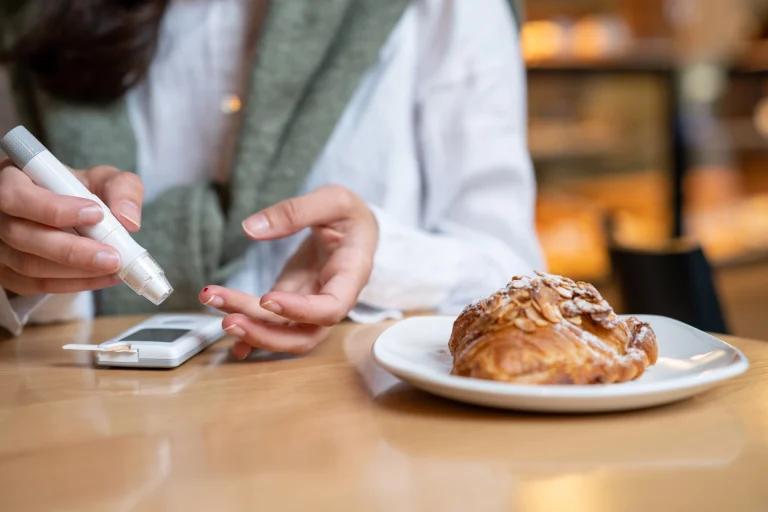We recently invited Nutritional Therapist, Beth Edwards to educate us on insulin sensitivity. By Beth Edwards (@bethedwardsnutrition)
Hello! Chances are if you’re reading this blog, you live with type 1 diabetes (T1D). Great! Me too. I’m Beth, a registered nutritionist and I help people with T1D live better through personalised nutrition, gentle coaching and lifestyle work.
The thing about T1D? It’s always on. Anyone who lives with the condition will most likely have a mind whirring with insulin doses, carb calculations or blood sugars. It can be both a tough gig and a lonely one.
When it comes to type 1 diabetes and nutrition, there’s so much noise out there and it’s getting noisier. Maybe you’re going around in circles about what you should be eating. Wondering whether to try keto vs high carb, low carb vs low fat, or whether or not to go vegan. I hear ya.
I’m here to cut through that. I offer evidence-based nutrition support that works. No fads, no judgement, no nonsense. This blog offers specific information and guidance around a little thing called insulin sensitivity. Maybe you’ve heard of it, maybe you haven’t. A word to the wise – optimising how your body responds to insulin will make your diabetes care and management a whole lot easier. So without further ado, let’s dive into insulin and how to get it sensitive!
Insulin sensitivity 101
Why is it important for anyone with T1D to view their management through the lens of insulin sensitivity? The goal is for us to keep blood sugar levels within a target range without losing our sanity (restriction is not the answer). A great way to manage blood sugars is to work on something called insulin sensitivity – the converse insulin resistance. You might think that resistance is exclusively an issue for those with type 2 diabetes. While insulin resistance is a hallmark of prediabetes and type 2 diabetes, it can also affect those with type 1.
When I work with clients, we implement changes that allow us to zoom out, look at the bigger picture and work on increasing insulin sensitivity in the background i.e. across the whole day, week, and month. This then allows them to enjoy a meal out (with unknown carb quantities) or tuck into a slice of birthday cake without entering the blood sugar rollercoaster too much. A slice of birthday cake might push you up and out of range, but what’s important is that we minimise how high blood sugars (hyperglycemia) go and that we encourage them to come back down quickly. Working on your insulin sensitivity allows for this.
So how do you improve insulin sensitivity?
It’s necessary to focus on a range of areas including hormones, nutrition, exercise, sleep cycles, inflammation, and biochemistry. These are the cornerstones of insulin sensitivity. Let’s look at a few topics below.
Nutrition
- Get Carb Smart: Current research indicates that insulin sensitivity can be increased by prioritising dietary carbohydrates that come from whole foods and complex sources. The Mediterranean diet also prioritises complex carbs and is another approach that supports not only blood sugar balance but overall health benefits and longevity in the long run. Why? Mostly because it has powerful anti-inflammatory properties, is high in fibre and focuses on both what you’re eating and how you’re eating (think big family celebrations, mindful consumption & healthy food relationships). Clinical and personal experiences have shown me that an anti-inflammatory Mediterranean approach with a diversity of complex carbohydrates can be highly effective at boosting the effects of insulin
Importantly, no one size fits all when it comes to food and type 1 diabetes. Maybe you follow a plant-based approach but your T1D pal adopts a lower-carb lifestyle. There is not one ‘perfect’ way of eating and lots of people can achieve their glycemic goals in a myriad of ways.
What’s key is that no matter how many carbs you choose to eat, it’s sensible to focus on complex sources and get Carb Smart. This way you will be consuming carb sources that offer the most nutrition and prevent any blood sugar spikes. Not all carbs are created equal.
So how do you get carb smart?
- Focus on whole foods, low glycemic load and complex carbs (instead of simple sugars)
- Oats in porridge or overnight oats
- Root vegetables roasted (butternut squash, sweet potato, parsnips)
- Lentils and pulses (add these to soups, stews, and salads)
- Grains like quinoa, brown rice, buckwheat
- The humble potato, or sweet potato if you fancy an extra dose of vitamin A
- Watch The Fat: particularly saturated and trans-saturated as they contribute to high cholesterol. It’s easy for us with type 1 diabetes to default to fat-heavy foods as they have little impact on blood sugars in the immediate term, but they will affect control over a longer period of time. Aim for mono- and poly-unsaturated fats like olive oil, nuts and seeds, avocado, and oily fish
- Power To The Plants: I’m not vegetarian or vegan, but I am a huge plant lover. And for good reason! Fruits and vegetables are packed full of antioxidants (basically, substances that prevent or slow damage to cells). For those living with T1D, upping your antioxidants is a smart move. Whenever blood sugars go out of range (which is inevitable, type 1 diabetes is not a perfect science and people with T1D are not robots), this can cause damage to our body cells. So, it’s smart to include a healthy number of antioxidants in your diet. Think of them as mops that are able to ‘mop up’ any free radical damage. The more colour, the better and diversity is key. Aim for 8 portions a day. If you can manage 10, you’ll be my new hero
Exercise
After nutrition, physical activity is the next best insulin sensitiser. Excess weight, obesity especially belly fat, and fat around your organs (visceral fat) reduces insulin sensitivity and increases the risk of type 2 diabetes mellitus.
A single session of moderate-intensity exercise can increase glucose uptake by at least 40%. Exercise allows glucose to shuffle into the cell (to be used for respiration) in the absence of insulin. Increasing exercise can increase insulin sensitivity for a few days post-exercise. Research also suggests that a combination of resistance and aerobic exercise workouts is the best. This is because cardio is the most potent insulin sensitiser, but resistance training can reduce blood glucose levels for the longest period post-exercise (up to 72 hours!). That being said, what’s important is that you find a way of moving that suits you and you can stick with – consistency is key!
Sleep
I know, I know – another healthcare professional banging on about the importance of sleep, but hear me out! Getting that shut-eye has a beneficial effect on all aspects of health, not just T1D management. It allows the body to conduct important maintenance work, repair any damage and stave off any illness. The latest research suggests a correlation between sleep loss and increased insulin resistance in populations of people with T2D, and one small clinical trial has shown that even 24 hours of sleep deprivation can lead to elevated fasting and post-meal blood glucose levels.
Stress management
Ever find that when you’ve got a stressful day at work, or you have to present in a meeting, you might find your blood sugars persistently elevated? Well, this is all thanks to our stress response.
What happens when we’re in sympathetic nervous system activation (fight or flight)?
- The body wants to ensure there is readily available sugar that can be used for energy
- The liver kicks in and releases stored glycogen into the bloodstream i.e. increasing blood glucose levels
- The body releases stress hormones including cortisol which makes us more insulin resistant, increasing blood glucose levels
Stress is a tricky one. The body is trying to help us out, but it’s a struggle for anyone who’s pancreatically-challenged. The main issue is that stress is unpredictable. Unlike carb counting, it’s hard to bolus the correct amount for stress. Plus, as soon as the stressor disappears, our blood glucose levels can drop quickly.
So, what can we do? Well, you can support your nervous system by using techniques to get your body into parasympathetic nervous system activation (rest and digest, the opposite of fight or flight).
Here are three destressing tips that you can adopt today:
- Breathing techniques. This is an excellent way to shift into rest and digest and begin to unwind. You could try box breathing (inhaling for a count of four, holding for a count of four and exhaling for a count of four), or 4-7-8 breathing (inhale for a count of four, hold four a count of seven and exhale for a count of eight).
- Meditation. Even if only for a few minutes a day, taking a pause to meditate can be an excellent way to lower stress levels (& lower blood glucose levels while you’re at it!). I like apps like Headspace, Insight Timer and Ten Percent, but there are also lots of free recordings on YouTube.
- Have different insulin ratios or basal profiles when you know you’re going to be feeling more stressed i.e. an exam.
Anti-inflammation
Let’s talk about inflammation for a minute. Acute (short-term) inflammation is triggered by damage to the body and should be “switched off” once the body has healed. Chronic (long-term) inflammation occurs when the switch doesn’t work correctly and turns inflammation from a helpful healing tool into something that causes unnecessary damage – and this is what’s been linked to cardiovascular disease (heart disease) and Alzheimer’s.
Type 1 diabetes can be considered a pro-inflammatory condition. It is also an autoimmune condition. Autoimmunity arises when incorrect immune responses target self-tissues causing inflammation. In T1D, cells attack the insulin-producing beta cells in the pancreas, causing irreversible damage.
Hence, adopting an anti-inflammatory diet is a great way to go for anyone with autoimmunity.
Top tips:
- Oily fish are packed with omega-3 fatty acids that are known to modulate the inflammatory response. Focus on salmon, mackerel, herring, and sardines and aim for 2-3 portions per week.
- Vitamin E is anti-inflammatory (find it in nuts, particularly almonds & seeds).
- Garlic, ginger and curcumin (found in turmeric) are excellent anti-inflammatory compounds. Add them freely to curries, stews and stir-fries.
- Vitamin C is another great option (you can load up by eating kiwi fruit, red bell pepper, strawberries, and oranges).
Pre-bolusing
One of my favourite tools in our T1D toolkit. Ensuring consistent pre-bolusing is really important when it comes to reducing those post-meal spikes.
Questions you need to ask when deciding how long to pre-bolus for:
- What is my current blood glucose?
- What food am I about to eat? (specifically, the glycemic load of carbs)
- Am I eating protein, fibre or fat with this meal? (These slow down the absorption of carbs)
- What meal is this? (i.e. breakfast may have the dawn phenomenon at play.
You can use the NowPatient app to create a quick reminder to have the food you’re planning to eat. In the process, you can also record your insulin to track exactly when it starts taking effect. The app will ensure you don’t forget. Alternatively, the timer on your phone so you don’t forget. For more detailed guidance on the latter method, read this Instagram post.
What About supplements?
Certain supplements have been indicated to improve insulin sensitivity. For example, alpha-lipoic acid, chromium, Myo-inositol and magnesium. It’s really important to work with a healthcare professional if you’re thinking of using supplements – in some cases, you might not need to supplement, or it may even be unsafe if you do.
- Working with a nutrition professional to help you target your individual challenges and blocks. If you’re struggling with insulin resistance, and are getting fed up with going around in circles, now might be the time to reach out for professional help.
You do you
At the end of the day, you know your body best but the key is lifestyle changes. Exercise, eating healthy foods, managing stress levels, maintaining a healthy body weight through weight loss or weight gain and reducing body fat are all great ways to improve your insulin sensitivity and help keep your diabetes under control. The above suggestions are based on what the current research is indicating, but some points might not resonate with you. That’s totally cool! I’m here to honour your individual biochemistry and accept that you’re in the driving seat of your condition.
I hope that’s helpful! You can follow me on Instagram where I share more tips and support to help you on your T1D journey. I also have plenty of resources on my.
Medical Disclaimer
NowPatient has taken all reasonable steps to ensure that all material is factually accurate, complete, and current. However, the knowledge and experience of a qualified healthcare professional should always be sought after instead of using the information on this page. Before taking any drug, you should always speak to your doctor or another qualified healthcare provider.
The information provided here about medications is subject to change and is not meant to include all uses, precautions, warnings, directions, drug interactions, allergic reactions, or negative effects. The absence of warnings or other information for a particular medication does not imply that the medication or medication combination is appropriate for all patients or for all possible purposes.









